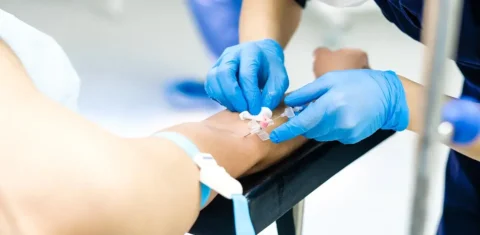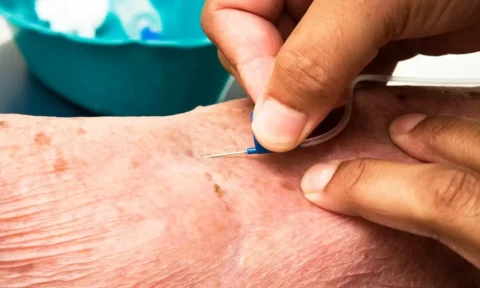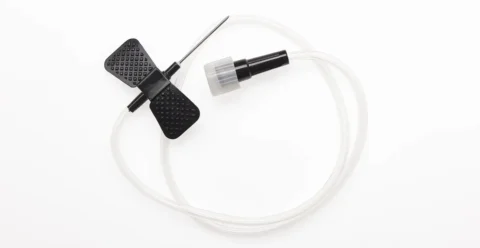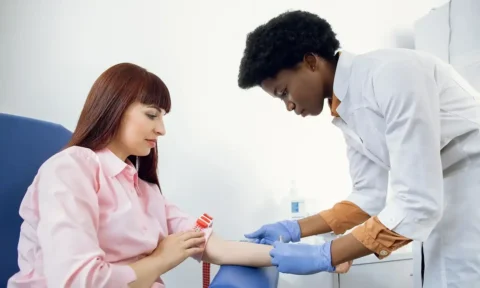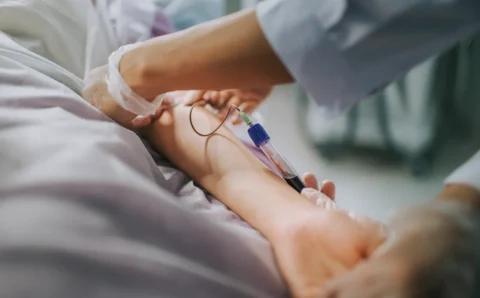The process of obtaining a blood sample isn’t only done for the purpose of monitoring a patient’s vitals and health condition. Some physicians also request a venipuncture to get blood cultures in individuals with suspected bacterial or fungal infections. There are different techniques and blood collection systems that can be used for this procedure, but the most common one is the butterfly needle.
So what’s the right order of draw in performing blood culture collection with a butterfly needle? If you’re using a winged infusion set for specimen collection, you should first fill the aerobic bottle to remove excess air in the tubing in the needle device. The air may compromise the anaerobic environment and result in underfilled blood culture bottles or facilitate the growth of aerobic and facultative microorganisms.
Blood Culture With A Butterfly Needle: Which Bottle Is Filled First?
Blood cultures are a type of laboratory test that helps detect the presence of microorganisms in a patient’s blood. When bacteria or fungi are confirmed to be living in the bloodstream, it can indicate an infection such as bacteremia or fungemia. If not treated properly, the growth of microorganisms may lead to severe health complications.
Like with most lab exams, the specimen for a blood culture test is taken via venipuncture. Physicians and healthcare workers can choose to use either a regular needle and syringe, an evacuated tube system, or a winged infusion set during the blood culture collection.
The butterfly needle set is more appropriate for microbiology specimen collection on younger or elderly patients. This is because its thin size and shallow-angle design make it less painful to access any small vein. If you’re using winged collection systems, you should always fill the aerobic or blue-top bottle first before the anaerobic or yellow- or purple-top bottle.
Aerobic vs. Anaerobic: What’s the Difference?
Aerobic and anaerobic are the two common kinds of blood culture bottles. In microbiology, these terms refer to the types of microorganisms that can grow in the blood. Here’s a table to help you better understand the difference between aerobic and anaerobic bottles:
| Aerobic | Anaerobic | |
| What it means in microbiology | These are bacteria and fungi that require oxygen to grow. Some common examples are Lactobacillus, Mycobacterium tuberculosis, and E.coli. | This refers to microorganisms that don’t need oxygen to thrive. It can sometimes be found in injured human tissue that doesn’t receive oxygen-rich blood. Some examples are Prevotella, Bacteroides, and Clostridium. |
| What it means in blood culture collection | An aerobic blood culture collection tube contains a growth medium that will reveal if a microorganism is contaminating the bloodstream. | An anaerobic bottle contains a reducing agent that will facilitate the growth of anaerobic agents. It also contains a gas mixture that doesn’t have oxygen. |
Importance of Initially Filling the Aerobic Bottle for Blood Culture With Butterfly Needle
Since there are two kinds of microorganisms, you need to obtain two different sets of blood cultures in the appropriate collection tube. This will help determine if the detected pathogens have contaminated the skin flora (anaerobic) or bloodstream (aerobic).
The aerobic blood culture bottle should always be inoculated first, especially if you’re using a butterfly needle. This blood collection set comes with a hollow needle, plastic wings, transparent tubing, and a connector that can be attached to a syringe or tube holder. You should note that its tubing normally has an excess of 0.5 cc of air which may affect the environment in the anaerobic bottle.
If you mistakenly put the specimen in the anaerobic bottle first, you may not get the intended results as the air may facilitate the growth of aerobes and facultative microorganisms. The only time that the anaerobic bottle will be filled first is if you’re using a needle and syringe for blood culture collection.
Other Blood Bottles That Are Commonly Used for Specimen Collection
In the practice of microbiology laboratory medicine, practitioners should follow the approved order of draw by the Clinical and Laboratory Standards Institute (CLSI). The order of draw basically refers to which blood bottles should be taken first according to the color of the top. This should be followed during blood collection to avoid cross-contamination since each specimen tube contains a specific additive.
Aside from the blood culture bottle, which is usually the first tube in the order of draw, here are the other bottles used for specimen collection:
- Coagulation tube (light blue top): This is also known as the sodium citrate tube which contains an additive which has an anticoagulant effect.
- Serum tube (red top): This blood collection tube may either contain a clot activator or not. Specimens in these tubes are used for serological tests to check the presence of antibodies against a microorganism.
- Heparin tube (light or dark green top): This test tube may contain a sodium heparin additive or lithium heparin additive with a gel separator.
- EDTA tube (lavender top): This collection tube contains a specialized additive that can prevent blood from clotting. It’s usually used for hematology tests such as full blood cell count, drug levels, and hemoglobinopathy screen.
- Glycolytic inhibitor tube (gray top): This can contain additives such as sodium fluoride to check for serum glucose and serum lactate levels.
Overview of Instructions for Blood Culture Collection Using A Butterfly Needle Set
It’s important that you observe careful measures and protocols in handling specimens for blood culture testing. Administering venipuncture with a butterfly needle is not quite the same as blood collection with a straight needle or evacuated tube. Here are the steps you need to follow for filling up the blood culture bottle with a winged infusion system:
1. Prepare instruments for blood culture collection
First, you need to prepare your medical equipment for specimen collection. Some of the instruments that you’d need are the winged infusion set, tube holder, tourniquet, sterile glove, 70% isopropyl alcohol, blood culture bottles (aerobic and anaerobic), clean gauze, pads, and tape.
Make sure that the tops of each blood culture tube are properly disinfected. Remove the caps and clean them with 70% alcohol and let them air dry. Put them aside and don’t retouch the bottle caps after disinfection.
2. Place tourniquet and cleanse skin
The next step is looking for the appropriate vein for the butterfly needle insertion. Apply the tourniquet at least 2 to 4 inches from the intended insertion site and palpate for the ideal vein. Once you’ve identified the site, wear your gloves and get your cotton swabs and soak it in a disinfectant solution with 70 isopropyl alcohol. Using a circular motion, wipe the skin with the swab to remove the dirt and debris then allow it to air dry.
3. Perform Venipuncture with the Butterfly Needle
Once the insertion area is dry, reapply the tourniquet and anchor the skin as you enter the butterfly needle into the vein. The needle should be inserted into the vein with a shallow angle of about 10 to 15 degrees. Place the aerobic bottle first inside the tube holder and collect blood until it reaches the desired amount. Using a swift motion, remove the aerobic bottle and immediately put the anaerobic bottle.
How Much Blood Should Be Collected for a Blood Culture Test?
The amount of blood specimens depends on the age of the patient. Blood culture tests for adults typically require 20 to 30 ml blood collection, with each bottle containing at least 10 ml. Meanwhile, the recommended blood volume collection for pediatric patients is based on their current weight. The total amount of specimens collected from children can vary from 5 to 10 ml.
4. Retract Butterfly Needle Once Vial or Tube Is Filled
When the blood collected reaches the desired level, immediately remove the tube from the holder. Get a clean gauze and place it above the insertion area so you can immediately apply pressure on the site once the butterfly needle is removed. Carefully pull the needle without unnecessary movements to avoid needlestick injuries and apply the gauze with minimal pressure to stop the bleeding.
Activate the safety device of the butterfly needle to automatically retract it. If it doesn’t have a push-button retraction mechanism, ask the patient to hold the gauze so you can use both hands to manually pull back the butterfly needle and dispose of it in the sharps container.
5. Properly Label The Blood Culture Bottle
Fill up and attach the labels with the patient’s full name, medical record number, and date and time of collection to the blood culture bottles. Follow your practice’s protocol on handling the collected specimen before sending the blood cultures to the clinical laboratory for testing.
What’s The Purpose of a Blood Culture Test?
A blood culture procedure helps identify the microorganisms present in the patient’s bloodstream and allows physicians to determine the proper treatment. Culturing the blood also checks for the microbes’ resistance to specific drugs so you can identify the right antimicrobial therapy for the patient.
Some of the common diseases that a blood culture test can help detect are:
- Meningitis
- Kidney infections
- Pneumonia
- Tuberculosis
- Sepsis
- Yeast infection
- Endocarditis
Pros of Using A Butterfly Needle for Obtaining Blood Culture
There are several reasons why some practitioners prefer butterfly needles over regular needle and syringe or evacuated tube for venipuncture and blood culture procedures. Here are some of the benefits of using a winged infusion set:
- Butterfly needles come in a variety of gauges and tubing lengths that allow for versatility in usage.
- It has a hollow needle which is smaller in size than a catheter, making blood collections, infusions, and injections less painful for the patient.
- It can be safely used to access hard-to-reach and fragile veins in the elderly population.
- It has a safety device that can be activated easily to reduce the risk of blown veins, nerve damage, and other percutaneous needle exposure injuries.
Buy High-Quality Needles, Syringes, and Other Medical Supplies at FACE Med Store
Blood cultures are an important medical procedure that can help rule out a bacterial or fungal infection in the bloodstream. If you’re taking a specimen with a butterfly needle, you should always fill up the aerobic bottle before the anaerobic tube to assure accuracy of blood culture results.
At FACE Med Store, we have a wide range of high-quality medical tools and instruments for your practice’s blood culture collection procedures. We also have butterfly needle sets that can be used for medical and aesthetic treatments. Call us today to know more about our products or browse our page to check our stocks.
